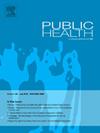Pandemic relief policies and public health: A study on emergency rental assistance and COVID-19 deaths in the USA
IF 3.2
3区 医学
Q1 PUBLIC, ENVIRONMENTAL & OCCUPATIONAL HEALTH
引用次数: 0
Abstract
Objectives
The COVID-19 pandemic risked exacerbating housing instability, prompting the allocation of substantial emergency rental assistance. This study leveraged the variation in county-level program adoption to investigate the relationship between the enactment of rental assistance programs and COVID-19 mortality rates.
Study design
Quasi-experimental study.
Methods
We identified counties that implemented rental assistance programs in 2020 from the COVID-19 Emergency Rental Assistance Database linked to administrative data. We contrasted the characteristics between counties with and without rental assistance programs. We estimated the effects of county-level emergency rental assistance programs on COVID mortality rates by applying propensity score matching combined with differencing techniques.
Results
A total of 2,993 US counties were included in this study, of which 170 counties (5.7 %) implemented COVID-19 emergency rental assistance programs in 2020 while 2,823 counties (94.3 %) did not. A comparative analysis of the counties revealed notable differences in race/ethnicity, education levels, income, poverty rates, healthcare resources, and health outcomes. COVID-19 emergency rental assistance programs were found to be significantly associated with an estimated reduction in monthly COVID death rates by 636 per 100,000 population.
Conclusion
Early-stage rental assistance funding played a crucial role in flattening the peak of the COVID-19 pandemic. These findings underscore the importance of incorporating financial support mechanisms into pandemic preparedness strategies, particularly before effective vaccines. Policymakers should consider these insights in future policy formulations aimed at enhancing epidemic response capabilities.
大流行救助政策与公共卫生:美国紧急租赁援助与COVID-19死亡研究
目的2019冠状病毒病大流行有加剧住房不稳定的风险,促使政府拨出大量紧急租房援助。本研究利用县级项目采用率的差异来调查租赁援助项目的实施与COVID-19死亡率之间的关系。研究设计:准实验研究。方法我们从与行政数据相关的COVID-19紧急租赁援助数据库中确定了在2020年实施租赁援助计划的县。我们对比了有和没有租赁援助计划的县之间的特征。我们采用倾向得分匹配结合差分技术,估计了县级紧急租赁援助计划对COVID死亡率的影响。结果美国共有2993个县被纳入本研究,其中170个县(5.7%)在2020年实施了COVID-19紧急租赁援助计划,而2823个县(94.3%)没有实施。对这些县的比较分析显示,在种族/民族、教育水平、收入、贫困率、医疗资源和健康结果方面存在显著差异。研究发现,COVID-19紧急租赁援助计划与每月COVID-19死亡率估计降低636 / 10万人显著相关。结论前期租赁援助资金在平抑疫情高峰中发挥了关键作用。这些发现强调了将财政支持机制纳入大流行防范战略的重要性,特别是在有效疫苗接种之前。决策者应在未来制定旨在加强流行病应对能力的政策时考虑这些见解。
本文章由计算机程序翻译,如有差异,请以英文原文为准。
求助全文
约1分钟内获得全文
求助全文
来源期刊

Public Health
医学-公共卫生、环境卫生与职业卫生
CiteScore
7.60
自引率
0.00%
发文量
280
审稿时长
37 days
期刊介绍:
Public Health is an international, multidisciplinary peer-reviewed journal. It publishes original papers, reviews and short reports on all aspects of the science, philosophy, and practice of public health.
 求助内容:
求助内容: 应助结果提醒方式:
应助结果提醒方式:


